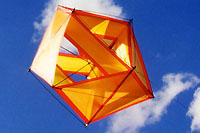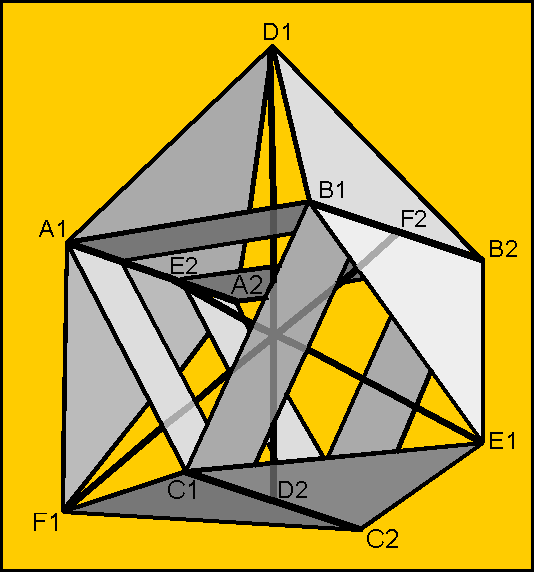 This
kite started life as a sketch by John Spendlove in European Kiteflier,
a short-lived magazine in the early 80’s. He invited people to come up
with a kite that had the outlines of a regular 14-sided geometric
body, more scientifically
known as a tetracaidecadeltahedral. But let's just call it
tetracaideca, that is already a mouthfull. One of the few kitefliers
that responded to his question was my brother Frits. The kites that
Frits and John built where mediocre fliers, mainly because the weight
of the construction was to high.
The construction of the kite depends on the stiffness of the longerons.
Twenty years ago the kite was framed with wooden spars, and the kite
was either too heavy or too fragile. A winged version was developed by
my
brother to distribute the forces better over the longerons.
Nowadays stiffness is not a problem, I redesigned the original kite
with a carbon frame, and now it is an excellent flyer in light and
moderate winds, but
as many compact box kites it can tumble out of the sky if the wind
suddenly
drops. This
kite started life as a sketch by John Spendlove in European Kiteflier,
a short-lived magazine in the early 80’s. He invited people to come up
with a kite that had the outlines of a regular 14-sided geometric
body, more scientifically
known as a tetracaidecadeltahedral. But let's just call it
tetracaideca, that is already a mouthfull. One of the few kitefliers
that responded to his question was my brother Frits. The kites that
Frits and John built where mediocre fliers, mainly because the weight
of the construction was to high.
The construction of the kite depends on the stiffness of the longerons.
Twenty years ago the kite was framed with wooden spars, and the kite
was either too heavy or too fragile. A winged version was developed by
my
brother to distribute the forces better over the longerons.
Nowadays stiffness is not a problem, I redesigned the original kite
with a carbon frame, and now it is an excellent flyer in light and
moderate winds, but
as many compact box kites it can tumble out of the sky if the wind
suddenly
drops.
click on the picture for larger image:
Sail construction: Use a low-strech ripstop fabric. Draw the panels A, B1 and B2 on the fabric in the quantities as shown in the plan, and cut them out along the outer lines. Sew panel B1 to panel B2 (6x) with a flat seam. Now you should have six equilateral triangles of fabric. Sew two of them together (3x) to form a diamond as shown in the plan. Sew reinforcement patches and loops of edge binding tape on the indicated spots. Sew the short edges of panel A together (2x). Hem the diamonds and panels A. Sew panels A onto the diamonds and sew tunnels as shown in the stitching scheme detail. |
 Frame:
Frame:
Longerons 8 mm carbon tube between points:
Cross spars 8 mm carbon tube between points:
Edge support spars 5 mm carbon
|
| Some varieties made by several dutch kite
flyers:
click on the picture for larger image: Framing: Pass the longerons (85 cm, 8 mm carbon tube) through
the tunnels, placing a T-joint at the middle of each longeron. Cut a hole
in the middle of a 7 cm long piece of vinyl tube with a 5 mm inside diameter
(6x). Pass the end of the longerons through the holes. Fix the ends to
the fabric with arrownocks and loops of braided line. Join the free corners
of the diamonds in pairs with a 20 mm loop of braided line. Insert one
end of the cross spars (8 mm carbon tube) into the T-joint and hook the
other end with an arrownock into a loop. Insert the 5 mm carbon spars into
the vinyl tubes to tension the edges of the panels A.
|